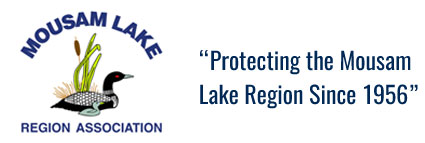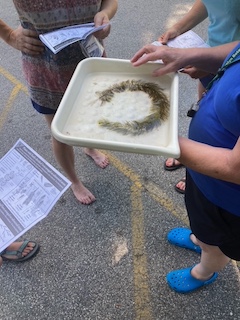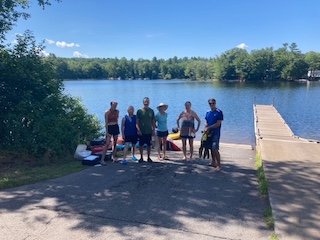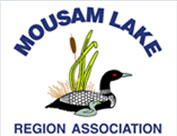MLRA Invasive Plant Patrol
| Helping to Identify Invasive Species In and Around the Lake | ||
 MLRA is currently working with YCIASP (York County Invasive Aquatic Species Program) to set up additional training opportunities for current and new IPP members. A typical invasive plant paddle event has these features: MLRA is currently working with YCIASP (York County Invasive Aquatic Species Program) to set up additional training opportunities for current and new IPP members. A typical invasive plant paddle event has these features:
The YCIASP-led IPP training session will start at 10 AM and end by 1 PM. The session will include: ➢ An introduction about the session, which takes place "on-shore" (approx. 15-20 minutes). ➢ After the “on-shore” introduction, the group will head-out onto the water and practice using the VLMP Quick Key as a group and will get familiar with some common native aquatic plants that occur in the water body (approx. 30-45 minutes). ➢ After becoming familiar with using the Quick Key and plants present, then the group will spend about 1–2 hours performing an invasive aquatic plant screening survey as a team.
➢ A VLMP IPP field data sheet will be completed for the session. That data will also be submitted to Lake Stewards of Maine.
Things participants need to provide:
➢ Workshop participants need to provide a kayak, canoe or other similar paddle craft and life preserver/personal flotation device (PFD). If they don’t have their own boat, they or the host organization can arrange for sharing a boat.
➢ Polarizing sunglasses are very useful for observing aquatic plants. Being a plant patrol member means you are equipped with the tools to know what to do when you see something out of the ordinary with plants in or around the lake. Patrolling for invasive aquatic plants primarily involves snorkeling, kayaking, or canoeing around the shoreline of the lake. If this is something you love to do or already do regularly throughout the growing season, then being a member of an IPP team is for you. YOU are the front line eyes on the lake and the first line of defense in protecting the lake from aquatic invaders. If you are interested in joining the MLRA IPP and covering your area on the IPP map, please email us at general@mousamlake.org. |
||
|
|
||
 |
||
|
| Helping to Identify Invasive Species In and Around the Lake | ||
 MLRA is currently working with YCIASP (York County Invasive Aquatic Species Program) to set up additional training opportunities for current and new IPP members. A typical invasive plant paddle event has these features: MLRA is currently working with YCIASP (York County Invasive Aquatic Species Program) to set up additional training opportunities for current and new IPP members. A typical invasive plant paddle event has these features:
The YCIASP-led IPP training session will start at 10 AM and end by 1 PM. The session will include: ➢ An introduction about the session, which takes place "on-shore" (approx. 15-20 minutes). ➢ After the “on-shore” introduction, the group will head-out onto the water and practice using the VLMP Quick Key as a group and will get familiar with some common native aquatic plants that occur in the water body (approx. 30-45 minutes). ➢ After becoming familiar with using the Quick Key and plants present, then the group will spend about 1–2 hours performing an invasive aquatic plant screening survey as a team.
➢ A VLMP IPP field data sheet will be completed for the session. That data will also be submitted to Lake Stewards of Maine.
Things participants need to provide:
➢ Workshop participants need to provide a kayak, canoe or other similar paddle craft and life preserver/personal flotation device (PFD). If they don’t have their own boat, they or the host organization can arrange for sharing a boat.
➢ Polarizing sunglasses are very useful for observing aquatic plants. Being a plant patrol member means you are equipped with the tools to know what to do when you see something out of the ordinary with plants in or around the lake. Patrolling for invasive aquatic plants primarily involves snorkeling, kayaking, or canoeing around the shoreline of the lake. If this is something you love to do or already do regularly throughout the growing season, then being a member of an IPP team is for you. YOU are the front line eyes on the lake and the first line of defense in protecting the lake from aquatic invaders. If you are interested in joining the MLRA IPP and covering your area on the IPP map, please email us at general@mousamlake.org. |
||
|
|
||
 |
||
|





